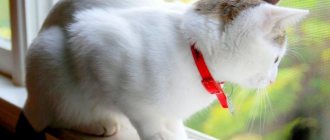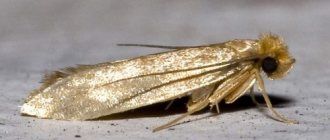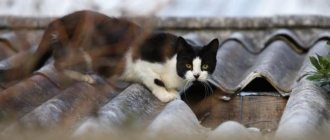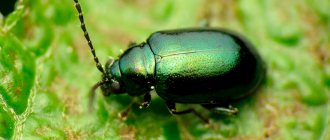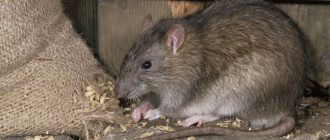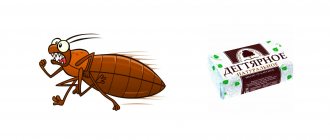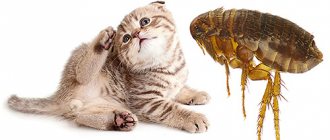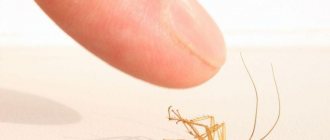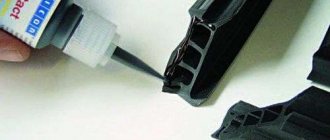Today, veterinary pharmacies and pet stores have a huge selection of anti-flea medications. However, sometimes it is better not to use insecticides to treat your pet. In such a situation, natural anti-flea remedies will help the owners.
We will find out what folk remedies for fleas exist, how effective and how dangerous they are, as well as how to use them correctly to quickly cure your pet.
Cause of fleas in cats
Blood-sucking parasites are capable of existing outside the animal for a long time. Eggs and larvae can develop in the environment and only then end up on a future host. Even one insect will be enough to start the process. Most infections occur on the street. No measures to prevent a domestic cat from communicating with stray animals will help: the parasite will always find a way to cling to hairs on a person’s skin or clothes. After this, the infection begins to multiply rapidly, spreading to upholstered furniture, carpeting and the animal’s bed.
Stay-at-home cats who do not have the opportunity to walk outside are also at high risk of parasitosis. As a rule, the person himself acts as a carrier. On the outer clothing of the owner or family members of a stray cat or dog, a flea can enter an apartment or house and spread through the fur of all the furry inhabitants of the apartment.
From a mother infected with bloodsuckers, all offspring become infected. The number of them on babies can be noticeably greater than on an adult cat. Rodents living in the yard also become carriers. There are a lot of ways to get infected. The main goal of the owner is to carry out effective preventive measures, and in case of trouble, begin treatment on time and prevent it from spreading throughout the house.
Cleaning the house against fleas
The process of ridding a cat of fleas also includes disinfecting the house. Without this event, it will not be possible to remove insects forever. Their eggs and larvae live in large numbers on carpets and upholstered furniture. And the parasites themselves can live behind baseboards or cracks in the floor.
General cleaning plan:
- Wash bedspreads, blankets, animal bedding, and soft toys. It is advisable that the water temperature be 60°C or higher. It is recommended to iron the cat's bedding after washing.
- Treat the floors, walls, upholstered furniture, and cat houses with insecticidal aerosols against fleas. Carry out the procedure wearing safety glasses, a respirator or protective mask, and gloves. There should be no children or animals in the room during the disinfection process. Leave the treated apartment for at least 4-6 hours. Afterwards the room is ventilated for 2-3 hours.
- Vacuum carpets and upholstered furniture thoroughly. Go through all corners, try to clean all hard-to-reach places (under sofas, beds, armchairs).
- Wet cleaning. Rinse the floors thoroughly with warm water with the addition of essential oils: geranium, pine, lavender, eucalyptus, mint, tea tree. This solution should be used to wipe furniture and window sills.
It is also necessary to thoroughly rinse the soles of outdoor shoes. It carries a large number of flea eggs.
Danger of infection
Uninvited residents on the pet’s body not only cause discomfort and the risk of spreading throughout the home, but also pose a serious threat to the health of the mustachioed friend.
How dangerous are fleas on a cat?
The main danger of fleas in cats is as follows:
- Bloodsuckers carry various infectious diseases. For example, infected cats have an increased risk of developing worms.
- Bites contribute to the formation of wounds, hair loss, deterioration of its structure and appearance.
- A large number of fleas and prolonged infestation cause the development of anemia, and in weakened kittens it can be fatal.
- The presence of wounds and abscesses provides access to allergens and the development of skin dermatitis.
The disease is especially difficult in elderly and weakened animals, in small kittens with a low immune system and in nursing mother cats.
Eliminating the consequences of flea bites
If there are still lesions on your cat's skin after flea removal, they need to be treated. Sores or scabs are smeared with healing ointments, which the veterinarian will recommend. To prevent the pet from scratching itself and licking the medicine, a collar is put on it.
In case of allergies, the animal is given antihistamines. The doctor will prescribe the medicine and dosage. To reduce itching, a special ointment is applied locally.
If fleas have caused helminthiasis in a cat, it is necessary to deworm it and other pets living in the same area. To do this, special anthelmintics are given twice, with an interval of 1-2 weeks. The dose calculation is based on the weight of the animal. Before use, you must carefully read the instructions for the drug.
Harm to humans
Flea infestation is also dangerous for people, because it can cause skin rashes, dermatitis and infection of the entire body. Parasites carry unpleasant diseases, the most dangerous of which are encephalitis and salmonellosis.
Fortunately, serious diseases are rarely transmitted through flea bites, but the very fact of insects living in the house becomes a big nuisance. They jump on surfaces and can bite a person's legs. The only measure is disinfestation in an apartment or house, which is carried out simultaneously with treating the animal for fleas.
Collar
Special repellent collars are saturated with an odor that fleas cannot tolerate, i.e. the product repels (but does not destroy insects). The collar is a porous tape, the material of which retains the smell of the substance applied to it well. This can be either a natural repellent - essential oil, which is safe for cats' health, or a small dose of a synthetic insecticide. For kittens and pregnant cats, collars with natural repellents should be used.
Experts recommend using collars as a preventative measure after the cat’s fleas have already been removed using more powerful insecticidal preparations, or used as a means of complex therapy (i.e. drops + collar). Repellent collars repel not only fleas, but also lice, scabies and ixodid ticks.
The effect of the flea collar lasts up to 8 months. It is very simple to use: just fasten the collar around the cat’s neck and trim off the excess. Do not remove it until the active substance wears off. There is a small “minus”: the fur under the collar cakes, and this is not suitable for cats that take part in exhibitions and competitions.
Collars popular with cat owners: “Bars” (AVZ), “Doctor Zoo”, “Bolfo” (Germany).
If a cat has scratches on its neck, you cannot use a collar; the active substance applied to it can get into the wound and cause a serious allergic reaction in the animal. You can put on a flea collar for cats only after the skin has completely healed.
Symptoms of infection
Veterinarians identify certain signs that indicate the presence of bloodsuckers. Symptoms directly depend on the extent of spread. There are 3 main stages:
- Initial, which can be detected by a very attentive owner during a thorough examination of the pet’s fur. The only obvious sign will be more frequent scratching than usual.
- The second stage is characterized by increased nervousness, sleep disturbances, and lack of appetite. The cat begins to gnaw something out of the skin, biting itself at the same time. Bloodsuckers are clearly visible on the hairline, especially at its base.
- The third stage is manifested by a clear deterioration in health, weight loss, and refusal to eat. Severe ulcers on the skin are noticeable, and allergic dermatitis begins. Hair falls out in clumps, the coat becomes very thin to the touch and becomes dull.
Any stage of the disease serves as a signal to begin active action. Timely treatment will help eliminate symptoms, help your pet, and prevent the spread of insects throughout the house or apartment.
Features of the insect
What are fleas? These are blood-sucking parasites. They are quite unpretentious and tenacious. Squashing a flea is not easy because of its body structure. The parasite has legs designed for jumping long distances. Fleas can go without food and survive for weeks this way. These insects are very prolific, which also poses a serious problem.
What do fleas look like and why are they dangerous?
Fleas have a mouthpart that allows them to bite through the skin of an animal and feed on its blood. Thanks to their laterally flattened body and small, rounded head, insects can move quickly through cat fur. On the surface of the flea's body there are bristly ridges, which also help the parasite cover distances on the animal's body. The flea has six legs, the back two of which are especially well developed. This allows fleas to jump up to half a meter.
These parasites pose a serious danger primarily to kittens, as well as weakened, sick and old animals. Fleas can cause anemia in kittens because one parasite drinks large amounts of blood. In the most advanced cases, fleas can lead to the death of the animal.
In addition to the fact that fleas feed on the blood of animals, they are also carriers of many dangerous diseases. For some types of helminths, fleas are an intermediate host. An animal can accidentally swallow a flea and then the helminth eggs enter the body directly, where they become larvae and then turn into adult parasites.
At the same time, the cat’s skin and fur also suffer greatly. The coat may fall out, lose shine and look unkempt.
Types of fleas in cats
The most common flea that affects cats is C felis, also known as the cat flea. The size of parasites of this species is small - from 2 to 4 mm. They do not have wings, and their small head and laterally flattened body allow them to easily move among the cat’s fur, clinging to the hairs with bristles and spines.
Where do fleas come from?
Fleas are parasites that are active all year round. They live not only on the street, but also in the basements of residential buildings and entrances. You may not even notice the larval eggs hidden in the corners of your apartment: behind baseboards, in cracks, in furniture and folds of linen. The larvae feed on dust and other contaminants, and then, upon reaching sexual maturity, migrate to a pet. Therefore, even a domestic cat can become infected with parasites that you accidentally brought from the street on your clothes or shoes.
Symptoms of flea infestation
You won't be able to avoid noticing fleas on your cat for a long time. The animal quickly begins to show the following signs of the disease:
- An infected cat begins to actively scratch and bite itself, trying to catch parasites.
- The animal is nervous and meows.
- Black crumbs on the skin are parasite excrement and dried blood from scratching bites.
- When examining the cat's back or scruff, you may notice bite marks.
- The presence of fleas themselves on the animal’s fur.
Are fleas the same on dogs and cats?
It happens that dogs and cats suffer from the same type of fleas. Dogs and cats can be parasitized by a specific type of parasite - the cat flea. At the same time, there is also a dog flea, which parasitizes exclusively on dogs.
How often can fleas be poisoned?
The procedure for killing fleas using special drops is carried out once. If necessary, the procedure is repeated after two months. At the same time, the room is treated with special means: the floor, baseboards and the animal’s sleeping area.
How to remove fleas from a cat at home
If fleas are found on a cat, you should immediately begin general cleaning. Along with treating the animal, thoroughly cleaning the house will be the main means of combating the further spread of insects. Eggs and larvae lie tightly on carpets, upholstered furniture and other household items. Everything should be treated with a vacuum cleaner and special chemical solutions designed to kill insects.
Types of insecticides
Almost all chemicals affect the nervous system of parasites, block the impulses of the endings, leading to paralysis and death. There is a large selection of insecticidal solutions that differ from each other in release form and are intended for treatment against fleas of cats:
- shampoo;
- spray;
- drops;
- collars;
- pills.
The active ingredients are also different. Thus, modern analogues contain pyrethroids or organophosphorus mixtures in their components. The first include substances such as phenothrin, permethrin, etofenprox. Their impact on the problem is delayed. The prolonged effect of the drugs allows the pet to forget about discomfort for a long time. Organophosphorus compounds have a powerful effect on parasites. However, such a composition can be dangerous for cats, so it is used strictly according to the instructions. Before deciding how exactly to remove fleas from a cat, you need to consult a veterinarian.
Anti-flea shampoos for cats
Shampoos are an effective means of combating blood-sucking insects. The components included in the composition are of synthetic and natural origin, all of them act by repelling or killing. In addition, the washing solution has a beneficial effect on the condition of the skin and coat. Hair becomes shiny and silky after use. Cleaning solutions are divided into 2 types according to their methods of action:
- The medicinal type contains insecticides that completely destroy insects. This is the drug that your veterinarian will recommend if you go to the clinic with the question “how to get rid of fleas on a cat.”
- Preventive, containing natural ingredients (extracts of coltsfoot, calendula, chamomile), essential oils (wormwood, geranium, cloves), which have a beneficial effect on the skin, coat and repel fleas.
The popularity of using such anti-flea compounds is explained by their ease of use. The animal should be soaped, wait a little time, and then thoroughly rinse off all the foam. There are shampoos designed to treat short-haired and long-haired individuals, the components of which, in addition to therapeutic and prophylactic effects, help the coat become softer, easier to comb, and prevent the formation of tangles.
Mild shampoos are suitable for use by small kittens because they do not irritate the skin and mucous membranes. Another advantage is the affordable price. It is the shampoo that the veterinarian prescribes when he discovers the first signs of fleas on the pet’s body. The biggest drawback is that there is no 100% guarantee of cure.
Flea drops for cats
Drugs released in the form of drops are considered easy to use and quite effective. Flea drops for cats should be applied to the skin in a place where the animal cannot reach with its tongue, for example, in the neck area near the skull. Manufacturers of the drugs claim that it is enough to apply the product once to the withers for the bloodsuckers to disappear from the pet’s body forever. Flea drops for cats contain insecticides. Chemical elements are presented so that the cat cannot be poisoned and the bloodsuckers die. The dosage of the drug is selected depending
on the weight of the animal:
- small cats – 0.5 ml (15 drops);
- average cat about 5 kg – 1 ml;
- large breeds weighing 10-20 kg – 2 ml.
Drops for kittens are used with great caution, because unnatural components have a bad effect on the baby’s well-being and can lead to intoxication of the entire body. For nursing cats, flea drops are selected individually, under the guidance of a veterinarian.
Flea sprays for cats
Veterinarians call sprays one of the safest anti-flea solutions. Currently, this release form is available at any veterinary pharmacy. The liquid is evenly distributed over the surface of the coat, applied against the direction of growth. Long-haired individuals are advised to comb after the procedure for ease of distribution. Small children should not be allowed near the pet for about 2-3 hours after spraying.
The price of aerosols ranges from 200 to 2000 rubles. Sprays often contain strong-smelling substances released from plants that repel parasites by forming a protective film. Sprays contain the following active elements: essential oil of geranium, cloves, lavender, glycerin, peppermint extract, silicone oil.
The disadvantage is considered to be ineffective against existing problems in the house. Therefore, furniture and carpets will have to be treated with a different composition. For this purpose, manufacturers produce insecticidal aerosols for indoor treatment. They contain stronger chemical elements. You cannot use such flea sprays for cats, especially at home - they are only used to treat furniture.
Other medicines
In addition to the remedies listed above, you can use injections for quick and complete relief, but they can only be used as prescribed by a veterinarian. The disadvantage of injections is increased toxicity, which requires strict adherence to the dosage. Only a veterinarian will tell you how to rid a cat of fleas by injection, and calculate the dose for each specific animal.
In addition to vaccines, there are also tablets.
As a rule, they have a pleasant taste, but are highly toxic. They should not be given to small kittens, pregnant or lactating pets, or weakened animals.
Any medicine is used only after the recommendation of a specialist. The doctor will be especially attentive to expectant mothers, nursing and elderly individuals. The doctor will advise you on how to rid your cat of fleas, select medications and prescribe the dosage along with the duration of treatment.
Rules for the use of insecticides
You need to be aware that all anti-flea solutions are made on the basis of toxic substances. Therefore, the cat and the owner can be poisoned by it if certain precautions are not taken:
- When treating wool with shampoo, do not allow it to penetrate the eyes or the mucous membrane of the mouth or nose.
- When washing your pet using chemical-based anti-flea solutions, wear rubber gloves.
- It is important to prevent the cat from reaching his tongue to the area treated with special drops.
- The spray is sprayed so that nothing gets into the eyes, nose, or mouth. Usually one person covers the animal's head with his hands, and the second does the processing.
- When treating wool with an aerosol, it is advisable to use a respirator.
- When cleaning a room, you must close it and keep animals and children away for the time specified in the instructions.
- Before allowing a pet or family member into the treated room, it must be ventilated for at least 2 hours.
- After the cat or room has been treated, as well as after using the treated collar, wash your hands thoroughly with soap.
- If the insecticide does get into your eyes, they should be immediately rinsed with warm water.
- If a chemical gets on the mucous membrane, the best solution is to call an ambulance.
If the box of an anti-flea compound indicates its absolute safety, a person or pet still has the possibility of individual intolerance to a particular component. Insecticides should not be used by people suffering from the following ailments:
- diseases of the liver and biliary system;
- allergies;
- chronic diseases of the nervous system;
- respiratory diseases;
- chronic eye diseases.
Inhalation of toxic components or contact with them can cause exacerbation of chronic forms of the disease or lead to attacks of suffocation and poisoning.
Folk methods of struggle
When it was not possible to go to a veterinary pharmacy, the owners treated the cats with self-prepared liquids. Some people still prefer to use folk remedies for fleas on cats instead of chemicals. As a rule, they treat not the animal itself, but the home, forcing annoying insects to leave the house. means remain
- sawdust and shavings of coniferous trees;
- wormwood herb;
- geranium;
- lavender;
- garlic;
- brewer's yeast;
- lemon tincture.
The main part of such medicines are pharmaceutical plants, the effect of which is caused by a strong aroma. In fresh or dried form, they have a pleasant smell for people, but an unbearable smell for insects. For example, the resin contained in shavings or sawdust quickly repels bloodsuckers. They are laid out under the bed or sewn directly inside the cat's bed. Wormwood has the same effect. This grass protects the cat from fleas and ticks, and dry wormwood powder scattered at the threshold will not allow insects into the house. For greater effect, wormwood is sometimes mixed with pine sawdust.
There is another way to use this herb: pour a handful of it with a glass of boiling water and keep it on low heat for 5–10 minutes. The broth is cooled and filtered. This infusion is used to treat the floor, upholstered furniture, carpets and the cat itself. The floors should not be washed after cleaning. This will enhance the anti-flea effect of the decoction.
Common geranium is a good repellent for blood-sucking insects, its smell makes them leave the room. A bouquet of tansy works the same way. A small bunch is placed under the bed or hung on the wall nearby. This grass will be even more effective when it becomes dead wood.
The scent of lavender is great for removing fleas. In this case, it is most convenient to use the essential oil of the plant, which can be bought at any pharmacy. A drop of aromatic substance is dripped onto the cat's bed. It is useful to add 5-7 drops to the water that should be used to wash the floor.
Sometimes garlic in combination with brewer's yeast helps to cope with the problem. To do this, both products are mixed in a ratio of 10:1. We must remember that excessive amounts of garlic can harm the animal. The resulting thick mass should be used to lubricate the floor, but carpets cannot be treated in this way. The solution has a suffocating effect for about 10-12 hours, and then the flooring is vacuumed well. The dried mixture is removed along with dead individuals and larvae.
Another eco-friendly option is lemon water. To do this, peeled citrus needs to be boiled in half a liter of water and left for about 7 hours. The broth is poured into a spray bottle and sprayed on all things and carpets in the house. This aerosol repels infection well due to its high content of essential oils.
How to get rid of fleas on a cat if folk remedies don’t help? There is only one way out - potent drugs in the form of drops, sprays or shampoos.
Precautions when using insecticides
Insecticides are based on poison. Both cats and their owners can be poisoned by the drug, so you need to take some precautions:
- When treating a cat with shampoo, it is important to prevent the product from getting into the eyes and mucous membranes of the cat’s mouth and nose;
- When washing your cat with insecticide-based anti-flea products, you need to use rubber gloves;
- the cat must not be allowed to reach with its tongue the area treated with anti-flea drops;
- the spray must be sprayed so that not a single drop gets into the cat’s eyes, nose or mouth;
- When treating a cat with a spray, you can use a respirator and safety glasses;
- when treating rooms, you need to close the room and keep cats and children away (for the entire period specified in the instructions);
- before allowing children into the treated room, it must be ventilated (at least 2 hours);
- after treating a cat or room, as well as after putting on an anti-flea collar, you should thoroughly wash your hands with soap;
- if you or other family members get insecticide in your eyes, you need to immediately rinse them with running water;
- If any insecticide gets on the mucous membrane (eyes, nose or mouth), it is recommended to consult a doctor or call an ambulance.
It is important to understand that even if the packaging of a flea product says that it is safe, some people may have an individual intolerance to a particular component. It is not recommended to use insecticides to control cat fleas for people suffering from the following diseases:
- chronic diseases of the liver and biliary system with frequent exacerbations;
- allergic diseases, including skin diseases;
- chronic diseases of the nervous system;
- dystrophic and allergic diseases of the upper respiratory tract;
- chronic eye diseases (eyelids, conjunctiva, cornea, lacrimal ducts);
- chronic diseases of the bronchopulmonary system with frequent exacerbations.
When treating cats and premises for fleas, it is recommended to use personal protective equipment.
How to choose the right product
The best insecticide is the one that will not only get rid of the infection, but also will not harm your pet. To choose the most effective one, we must not forget about several points:
- pet's age;
- health characteristics: allergies, intolerance to a component;
- physical state;
- specific properties of the drug;
- conditions of use: house or apartment;
- the presence of a child or elderly person in the house.
If you know exactly how, why and where to use a special tool, then choosing the right one will not be difficult. A veterinary pharmacy employee can give the correct recommendations. After purchasing a specific insecticide, you should carefully study the instructions. For prevention, collars or drops on the withers are best suited, which have a gentle effect on the cat itself, but do not lead to side effects.
For domestic cats that often walk outside, collars soaked in chemicals or natural essential oils are also suitable. You can remove them at home - then the skin will not be irritated. Animals that are taken to the country need to have drops applied to their withers.
How to safely remove fleas from a kitten? Offspring from 1 month of age are bathed with special medicinal compounds. For older children, drops are applied to the withers, and then collars are put on. In case of severe infection, they resort to the use of special aerosols.
Causes and signs of infection
It is quite easy to find out about the presence of fleas in your pet; just pay attention to what the cat looks like. The animal is constantly in a restless state, as pests bite and drink blood. Cats are constantly itching and gnawing themselves, trying to catch insects in their fur. The pet's anxiety will depend on how many parasites are present on the body. The more fleas are in the fur, the more they bother your pet.
Modern veterinary pharmacies offer a wide range of anti-parasite products.
In addition to excessive scratching, the following signs are present:
- nervousness;
- the animal constantly meows;
- appetite worsens;
- lethargy and weakness.
For your information! If treatment is not started in time, fleas will continue to multiply, and non-healing wounds will form at the sites of scratched bites.
To make sure there are fleas, you need to inspect your pet's fur. It is best to do this on your stomach. Moving the fur in different directions, you need to carefully examine the cat's skin. The presence of fleas will be indicated by adhered excrement and larvae, as well as running adults.
Before answering the question of how to remove fleas from a cat, it is necessary to study the routes of infection. Since parasites are very tenacious insects, you can catch them anywhere.
Where do parasites come from:
- staying outside. It is enough to take a cat outdoors once for him to become infected with fleas. You can catch them not only from other cats, but also from grass, trees, and walking paths;
- Often the carrier is the person himself. It is enough to pet another cat for fleas to attach themselves to a person’s clothing. This way the owner can bring the parasites home;
- you can get infected from rodents, especially if the cat hunts often;
- fleas pass from adults to kittens.
How to get rid of fleas on a kitten or mother cat
Kittens are treated with the same substances that are used for adults, only at more gentle levels. Many manufacturers make special products for babies. The owner needs to read the ingredients very carefully. Kittens are more susceptible to flea infestation, and the reaction to medications may be stronger. It is dangerous to use chemicals to treat newborn offspring up to one month of life. They have a very weak immune system, so they can get poisoned and die. In order to save your baby from the problem, you can take the following measures:
- comb out with a fine comb, between the teeth of which larvae and adults will get stuck - such devices are sold at the pet store;
- wash and change the kitten’s bedding;
- vacuum the infected room, placing aromatic herbs (wormwood, geranium) in the corners.
Cleaning activities must be carried out every day. If this does not completely get rid of bloodsuckers, it will still allow you to wait until the time when serious treatment can be used.
At the same time, traditional methods are used. In any case, there will be fewer parasites, and the baby will stop suffering greatly. When he is one month old, you can go to a veterinary pharmacy and purchase everything you need for treatment. is almost always used :
- combing with a fine-toothed comb;
- bathing with anti-flea shampoo;
- use of anti-flea drops, sprays or collars.
It is not recommended to use any medications for lactating and pregnant females. Only if a cat has a very severe flea infestation, which threatens serious consequences for the offspring, is it permissible to use products on the withers or bathe with detergents.
Shampoo
Shampoo is the mildest remedy in the fight against blood-sucking insects. Special shampoo formulas have been developed that not only make pets' fur clean, but also destroy fleas.
Using shampoo, you can get rid of fleas even in pregnant cats, for whom the use of insecticides contained in flea drops is contraindicated.
Benefits of using shampoo for fleas in cats:
- affordable price;
- ease of use;
- low toxicity;
- Possibility of use for washing cats that are allergic to insecticides.
Shampoo can be dry, which must be used without water, or regular, which must be washed off the animal’s fur. Particular attention should be paid to rinsing the fur; this must be done very carefully, because cats, no matter how well they are wiped, will still lick themselves.
When choosing a detergent, you should pay attention to what breeds of cats the flea shampoo is intended for: long-haired, short-haired or hairless. It should also be clarified at what age this remedy can be used. The fact is that shampoo for small kittens and pregnant cats contains a minimal amount of toxic ingredients, and in the product for washing adult animals their concentration is much higher.
Experts recommend the following types of shampoos: “BIO-GROOM” (USA), “Bars” (AVZ), “Fitoelita” (Veda).
Flea shampoos for cats consist of three main ingredients:
- components that create soap foam;
- substances that care for the animal's fur. These are decoctions of medicinal herbs, essential oils;
- insecticides. Both synthetic substances (phenothrin, decamethrin) and natural ones (penitrin contained in Caucasian and Persian chamomile) are used.
Room treatment
Without treating all rooms in the house, treating a cat may be ineffective - at best, it will take several weeks, at worst, several months. Therefore, the animal and the entire room should be treated simultaneously.
Special means
The easiest way is to purchase sprays that kill insects. The label must indicate that the product is also suitable for getting rid of fleas - not all aerosols are designed for these insects.
The treatment is carried out quickly so as not to inhale the toxic substance. The nose and mouth should be covered with a scarf or scarf.
The product is kept for from half an hour to 3 hours (the exact time is indicated on the label), and then the room is thoroughly ventilated for at least an hour. If possible, it is better to treat all the rooms at once, and at this time, together with the animals, be in another place. If this is not possible, then the rooms are processed in turn, but on the same day.
Some products require rinsing off—usually insecticides designed to be sprayed exclusively on floors and baseboards.
Traditional methods
To eliminate and prevent the appearance of fleas, aromatic herbs or dead wood are often used. These are geranium, mint, wormwood, sage, tansy, lavender. Plants are placed in floor pots, and dead wood is placed in small quantities behind baseboards and ventilation grilles.
It is recommended to wash floors by adding 5-10 drops of essential oils to the water. Many of them repel insects and fill the air with a pleasant aroma and freshness.
Call exterminators
Exterminators are called in in severe cases:
- there are fleas not in one apartment, but in several, and large-scale treatment is required;
- fleas live in the basements of apartment buildings;
- fleas have settled in the basement of a private house.
In these cases, a team of specialists treats all premises with very strong agents. Usually after the procedure you can return home only on the second or third day, and before that you need to ventilate your home for 10-12 hours.
Folk remedies to help
Your cat has worms: how to treat them at home
Among folk remedies there are a couple that can fight fleas.
Citrus fruits against parasites
Every owner should know how to rid a cat of fleas at home. The safest folk remedy is citrus spray. To prepare the product, you need to finely chop the lemon, pour it with warm water and leave the tincture for 24 hours. After preparation, it is necessary to treat the animal’s hair with a spray bottle.
Sagebrush
To obtain a decoction based on wormwood, you need to pour 50 g of the plant with water and then boil it. The product must be cooled and filtered before use. Fur should be treated, as well as bite wounds.
Wormwood is an environmentally friendly and effective remedy against fleas
Note! Wormwood can be combined with eucalyptus and lavender. To do this, all components are mixed and filled with water. The broth is kept on fire for 15-20 minutes, then it is removed and cooled. It is recommended to use the product for at least 10 days.
Vinegar and garlic for fleas
Garlic, which has a detrimental effect on parasites, is suitable as a handy remedy for fleas. To prepare the tincture you will need 5 cloves of garlic, which should be chopped. The product is poured with 3 glasses of water and left to infuse for 12 hours. The wool should be wiped with the prepared tincture 3-4 times a day.
Using vinegar is a last resort, but it works well against insects. Vinegar, ammonia and cologne should be mixed in equal proportions. The resulting mixture is treated with a spray bottle. For the drug to work better, it is necessary to place the cat in a plastic bag (the head is not covered). You need to hold the pet for 7-10 minutes, then rinse the fur with plenty of water and comb it out.
Salt
You can remove fleas using salt diluted in water. You will need 1 kg of product, as well as 8-10 liters of water. Hydrogen peroxide can also be added to this mixture.
After the salt has dissolved, the cat should be washed in the resulting mixture. Finally, you need to rinse the wool to remove salt in warm water.
Salt remedies and geranium decoction
Salt and water are mixed in equal proportions. The resulting powder should be infused for 10-12 hours. The product must be poured onto the animal’s fur, but you should make sure that the pet does not eat it. After 30 min. it is necessary to wash off the composition from the animal.
To prepare a decoction of geranium, you need to pour the main component with water and add 30 g of lavender. The mixture is kept on fire for 10-15 minutes, then cooled and filtered. It is necessary to bathe the animal in the resulting solution.
Are fleas dangerous for humans?
Fleas can cause discomfort not only to pets, but also to humans. At times, parasites bother people by biting them, and any fears about this are not unfounded. After the bites of these parasites, unpleasant consequences can be observed on the skin in the form of blisters and papules. In addition, fleas can cause a skin infection in humans, which manifests itself in the form of ulcers or abscesses.
A person can become infected with helminthiasis by accidentally getting cat fleas into their mouth. The disease is asymptomatic in most cases.
Are cat fleas transmitted to humans? This depends on the gender and age of the pet. For example, a kitten's fleas are more likely to be transmitted to humans and begin to bite both the animal and its owner. Fleas are transmitted from cats to humans more often than from cats.
Safe pest control products
One of the important components of cat treatment is how safe the chosen method is for the pet’s health. To avoid harming your cat, you can opt for natural and safe products.
Combing out fleas
Short-haired cats can be combed with a fine-tooth comb. Brush the coat with a fine-tooth comb and then with a fine-tooth comb. Shake parasites from combs into a bowl of soapy water. In this way, you can remove some fleas from the skin of animals, but this will not completely solve the problem.
Herbal treatment and eco-collar against fleas
Some herbs, such as chamomile, rosemary, wormwood and wormwood, geranium and tansy, are considered natural remedies for fighting parasites. There are three ways to herbally treat an animal:
- Herbal rub. Soak a cotton swab in the herbal infusion and wipe the cat's fur.
- Herbal shower. Rinse your cat's fur with the herbal infusion and let it dry.
- Herbal powder. Sprinkle the powder on the areas where insects are most concentrated on the animal’s body.
To make your own eco-collar that is safe for your cat, you will need absorbent fabric. Sew a strip from it around the circumference of the animal’s neck, adding 2 cm to the length. Sew Velcro on both sides of the collar and treat the fabric with a special compound:
- 1 drop of lavender oil;
- 1 drop of thyme oil;
- 1 drop of eucalyptus oil;
- 1 drop of citronella oil;
- 5 ml alcohol;
- 10 ml jojoba oil.
Do not wring out the collar and place it on the animal's neck. After 30 days, replace the eco-collar.
Washing the bed, toys and cleaning the house
These harmful insects live not only on the animal, but also where the cat spends the most time. To kill any parasites living in your cat's bed, wash it in soapy, hot water at least once a week.
Aromatization of the room
If you have an aroma lamp, then you can scent the room. Use essential oils of lavender, thyme, rosemary, tea tree or eucalyptus.
You can also finely chop the garlic and place it on plates around the apartment. This smell will repel fleas.
If you like to grow flowers, then plant geraniums or lavender in pots.
Boosting immunity and love
Make your pet's diet balanced and add vitamins to it. The best option would be to switch to high quality food. Add brewer's yeast to your cat's diet - fleas cannot tolerate it.
Don't forget to show love and care. Give your pet attention and play with her. As a rule, happy animals do not get sick as often.
The danger of fleas for a cat and its owner
The flea belongs to the group of ectoparasites, i.e. parasites that live outside the body of their host. By piercing the victim's skin, it does not inject anesthetic substances into the blood, so flea bites are painful for animals. In an effort to relieve discomfort, the cat scratches the affected areas of the body, the skin becomes inflamed and covered with wounds.
Fleas pose the greatest danger to pregnant cats, kittens and pets with chronic diseases. In them, parasites cause anemia, allergies, loss of strength and a weakened immune system.
Fleas are intermediate hosts of some types of worms, including the bovine tapeworm. Therefore, treating pets for fleas should be accompanied by anthelmintic therapy.
In addition, fleas carry some dangerous infections.
Among them:
- encephalitis;
- hepatitis C and B;
- tuberculosis;
- plague;
- typhus;
- brucellosis.
Diseases transmitted by fleas.

